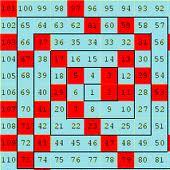What’s So Special About 733?
 This is a nice resource from Erich Friedman, a math professor at Stetson University: it’s a list of distinctive characteristics of [most of] the numbers between 1 and 9999:
This is a nice resource from Erich Friedman, a math professor at Stetson University: it’s a list of distinctive characteristics of [most of] the numbers between 1 and 9999:
http://www2.stetson.edu/~efriedma/numbers.html
Now, maybe knowing that 215 is equivalent to 555 in base 6 isn’t that useful, but there are a lot of great ideas woven throughout this list of integers. If you can fill in any of the gaps (do you know anything distinctive about 6821?), I’m sure Dr. Friedman would love to hear from you.
4 Comments
Sam Kolins · October 18, 2010 at 6:51 pm
If you search Sloane’s numerical series website, and type in “6821” (chose that because that’s the number you mentioned here), you can find all sorts of interesting patterns 6821 appears in. I’ve done so here: http://www.research.att.com/~njas/sequences/?q=6821&sort=0&fmt=0&language=english
I don’t know, or think, that any of these are significant or interesting enough to be included, but it’s an interesting way to seed through the remaining numbers at least. Unfortunately, I don’t think the findings from this would be nearly as interesting as the ones already given.
Sam Kolins · October 18, 2010 at 6:59 pm
The other cool thing I noticed while reading through this again is that 357, 358, 359 all have the same special property: their base 3 representation ends in their base 7 representation. I wonder if there are other consecutive pairs, or triplets, or higher, that follow the same pattern of having the same property?
Sam Kolins · October 18, 2010 at 7:00 pm
As it turns out, 370 and 371 are both narcissistic numbers. The hunt continues.
MrHonner · October 21, 2010 at 6:54 pm
What’s a narcissistic number?